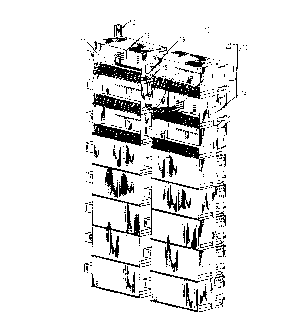Some of the information on this Web page has been provided by external sources. The Government of Canada is not responsible for the accuracy, reliability or currency of the information supplied by external sources. Users wishing to rely upon this information should consult directly with the source of the information. Content provided by external sources is not subject to official languages, privacy and accessibility requirements.
Any discrepancies in the text and image of the Claims and Abstract are due to differing posting times. Text of the Claims and Abstract are posted:
| (12) Patent: | (11) CA 2147909 |
|---|---|
| (54) English Title: | TELECOMMUNICATIONS DISTRIBUTION FRAME WITH TRACING |
| (54) French Title: | REPARTITEUR A LOCALISATION POUR LES TELECOMMUNICATIONS |
| Status: | Expired and beyond the Period of Reversal |
| (51) International Patent Classification (IPC): |
|
|---|---|
| (72) Inventors : |
|
| (73) Owners : |
|
| (71) Applicants : |
|
| (74) Agent: | KIRBY EADES GALE BAKER |
| (74) Associate agent: | |
| (45) Issued: | 1999-03-16 |
| (22) Filed Date: | 1995-04-26 |
| (41) Open to Public Inspection: | 1995-12-10 |
| Examination requested: | 1995-04-26 |
| Availability of licence: | N/A |
| Dedicated to the Public: | N/A |
| (25) Language of filing: | English |
| Patent Cooperation Treaty (PCT): | No |
|---|
| (30) Application Priority Data: | ||||||
|---|---|---|---|---|---|---|
|
Disclosed is a distribution unit which provides means for tracing patch
connections. Each module is electrically connected to a shelf controller through a
backplane. The shelf controllers are, in turn, coupled to a host computer. Pressing a
button on one module lights an LED on that module and on the module which shouldbe connected thereto based on the data base in the host computer.
L'invention est une unité de distribution qui permet de suivre les connexions de raccordement. Chaque module est électriquement connecté à un contrôleur par l'intermédiaire d'un fond de panier. Les contrôleurs sont à leur tour connectés à un ordinateur hôte. Quand on appuie sur un bouton sur l'un des modules, une diode luminescente s'allume sur ce module et sur celui qui devrait y être connecté d'après la base de données conservée dans l'ordinateur hôte.
Note: Claims are shown in the official language in which they were submitted.
Note: Descriptions are shown in the official language in which they were submitted.

2024-08-01:As part of the Next Generation Patents (NGP) transition, the Canadian Patents Database (CPD) now contains a more detailed Event History, which replicates the Event Log of our new back-office solution.
Please note that "Inactive:" events refers to events no longer in use in our new back-office solution.
For a clearer understanding of the status of the application/patent presented on this page, the site Disclaimer , as well as the definitions for Patent , Event History , Maintenance Fee and Payment History should be consulted.
| Description | Date |
|---|---|
| Inactive: IPC expired | 2013-01-01 |
| Inactive: IPC from MCD | 2006-03-11 |
| Inactive: IPC from MCD | 2006-03-11 |
| Inactive: IPC from MCD | 2006-03-11 |
| Time Limit for Reversal Expired | 2003-04-28 |
| Letter Sent | 2002-04-26 |
| Grant by Issuance | 1999-03-16 |
| Inactive: Final fee received | 1998-12-01 |
| Pre-grant | 1998-12-01 |
| Notice of Allowance is Issued | 1998-06-04 |
| Letter Sent | 1998-06-04 |
| Notice of Allowance is Issued | 1998-06-04 |
| Inactive: Status info is complete as of Log entry date | 1998-06-01 |
| Inactive: Application prosecuted on TS as of Log entry date | 1998-06-01 |
| Inactive: Approved for allowance (AFA) | 1998-04-23 |
| Application Published (Open to Public Inspection) | 1995-12-10 |
| Request for Examination Requirements Determined Compliant | 1995-04-26 |
| All Requirements for Examination Determined Compliant | 1995-04-26 |
There is no abandonment history.
The last payment was received on 1998-02-27
Note : If the full payment has not been received on or before the date indicated, a further fee may be required which may be one of the following
Please refer to the CIPO Patent Fees web page to see all current fee amounts.
| Fee Type | Anniversary Year | Due Date | Paid Date |
|---|---|---|---|
| MF (application, 3rd anniv.) - standard | 03 | 1998-04-27 | 1998-02-27 |
| Final fee - standard | 1998-12-01 | ||
| MF (patent, 4th anniv.) - standard | 1999-04-26 | 1999-03-30 | |
| MF (patent, 5th anniv.) - standard | 2000-04-26 | 2000-03-20 | |
| MF (patent, 6th anniv.) - standard | 2001-04-26 | 2001-03-19 |
Note: Records showing the ownership history in alphabetical order.
| Current Owners on Record |
|---|
| AT&T CORP. |
| Past Owners on Record |
|---|
| FRANK SALVATORE LEONE |
| RICHARD JOSEPH PIMPINELLA |